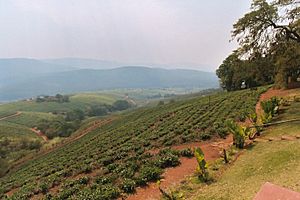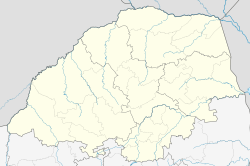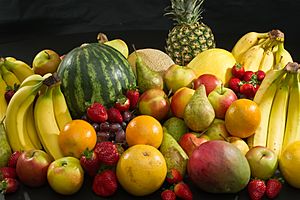Tzaneen facts for kids
Quick facts for kids
Tzaneen
Tsaneng
|
|
|---|---|

Tea and more plantation in Tzaneen
|
|
| Country | South Africa |
| Province | Limpopo |
| District | Mopani |
| Municipality | Greater Tzaneen |
| Area | |
| • Total | 22.16 km2 (8.56 sq mi) |
| Elevation | 719 m (2,359 ft) |
| Population
(2011)
|
|
| • Total | 14,571 |
| • Density | 657.54/km2 (1,703.0/sq mi) |
| Racial makeup (2011) | |
| • White | 46.1% |
| • Black African | 45.0% |
| • Indian/Asian | 7.0% |
| • Coloured | 1.0% |
| • Other | 0.9% |
| First languages (2011) | |
| • Afrikaans | 41.5% |
| • Northern Sotho | 18.1% |
| • Tsonga | 13.5% |
| • English | 13.4% |
| • Other | 6.4% |
| Time zone | UTC+2 (SAST) |
| Postal code (street) |
0850
|
| PO box |
0850
|
| Area code | 015 |
Tzaneen is a big, green town in South Africa's Limpopo province. It is known for its warm, wet weather, which is perfect for growing tropical and subtropical crops. It is the second biggest town in Limpopo, after Polokwane.
Around 475,000 people live near Tzaneen. The town itself had about 14,571 people in 2011. Many people in Tzaneen speak Afrikaans. The area also has many Tsonga and Balobedu people. Tzaneen is about 420 km (260 mi) from Johannesburg.
Contents
What Does the Name Tzaneen Mean?
The name Tzaneen comes from a Northern Sotho word, 'Tsaneng'. This word refers to a small basket called 'Tsana'. These baskets were made from bamboo grass called Lehlaka.
The area was famous for its high-quality bamboo grass. People used this grass to make many different tools. The 'Tsana' basket was very popular, attracting customers from far away. Because of this, the area became known as DiTsaneng, meaning "a place where Tsanas are made."
The area near the Great Letaba River was called Tsanakolo, which means "the place of the big reed." The Balobedu people were the first to live here. European settlers later built the modern town and kept the name Tzaneen.
Exploring Tzaneen's Geography
Tzaneen is often called 'Land of Silver Mist'. This is because mist often covers the mountains above the town. It is surrounded by lush, tropical plants.
Tzaneen is home to Limpopo's highest mountain, the Iron Crown Mountain. It stands over 2,200 m (7,200 ft) above sea level. This mountain is also known as Wolkberg, which means "Cloud Mountain" in Afrikaans.
The Wolkberg supports many different plants and animals. It has South Africa's second largest natural forest. The weather here can change quickly from sunny to misty. Rare plants and animals live in these mountains.
Some butterflies, like the Wolkberg Zulu and Wolkberg widow, are named after these mountains. The critically endangered butterfly, Lepidochrysops lotana, is found in only two places in the world, and one is the Wolkberg area. The Iron Crown Mountain is a protected area. The Groot Letaba River, Middle Letaba River, and Klein Letaba River all start in these mountains.
Farming and Agriculture in Tzaneen
Tzaneen is a major farming area. It produces a large amount of South Africa's fruits and vegetables. For example, Tzaneen grows about:
- 40% of South Africa's avocados
- 40% of South Africa's mangoes
- 20% of South Africa's bananas
- 90% of South Africa's tomatoes
The ZZ2 farms in Tzaneen are among the world's biggest tomato producers. Tzaneen is also the largest producer of pine trees in Limpopo. Most of Tzaneen's natural forests were cleared to make way for farms.
The town's economy relies a lot on farming fruits, vegetables, animals, and timber. Water for farming comes from dams like Tzaneen Dam and Merensky Dam. Many farms also use water from boreholes.
You will see many fruit farms in Tzaneen, growing mangoes, bananas, oranges, tomatoes, and avocados. Pine and eucalyptus tree farms are also common. These trees are used by sawmills in the area.
Education in Tzaneen
Tzaneen works to provide good education and training for everyone. The area has many people who have finished college or university. However, finding jobs after graduation can sometimes be difficult.
Sports and Recreation
The main sports in Tzaneen are soccer and rugby. Soccer is very popular in the rural areas and townships. Mountain hiking is also becoming popular, with clubs like Tzaneen Hiking Club.
Tourism and Attractions
Tourism is an important part of Tzaneen's economy, along with farming. Tzaneen offers many places for visitors to stay.
There are many fun places to visit around Tzaneen, such as the beautiful Tzaneen Dam, Magoebaskloof, Haenertsburg, and the Wolkberg mountains. The town is also close to several game reserves. Many tourists pass through Tzaneen on their way to places like the famous Kruger National Park, which is about 100 km (62 mi) away.
The Vervet Monkey Foundation is just outside Tzaneen. It takes care of over 600 vervet monkeys.
Tzaneen's Weather
Tzaneen usually has sunny, long summer days and pleasant winters. Its subtropical climate means it gets a lot of rain in summer, which helps dense forests grow.
From September to March, the average temperature is about 28 °C (82 °F). In winter, it is around 15 °C (59 °F). The town gets about 800 mm (31 in) of rain each year, while the mountains can get over 1,500 mm (59 in).
Notable People from Tzaneen
- Tito Mboweni (born 1959), a businessman and economist.
- Cassel Mathale, a former Limpopo Premier.
- Marchant de Lange (born 1990), an international cricketer.
- Master KG, a singer and record producer.
- King Monada, a singer.
- Mahlatse "Chiliboy" Ralepelle (born 1986), a rugby player.
- Trevor Nyakane, a South African rugby union player.
- Judas Moseamedi, a soccer player.
- Andrew Rabutla, a former soccer player.
- Ernst Roets (born 1985), Deputy CEO of AfriForum.
- Peta Teanet, a music producer and singer.
- Benny Mayengani, a singer.
- Ndavi Nokeri, Miss South Africa 2022.





